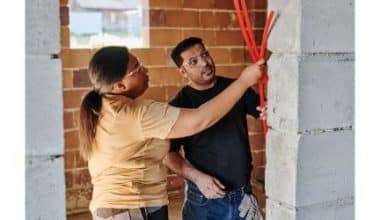The amount of dwelling insurance coverage you need for a condo is based on the price at which you can rebuild your home and any outbuildings, like a garage, front porch, or back deck, using today’s building materials and techniques.
How Much Dwelling Coverage Do I Need?
Dwelling coverage protects the structure of your home, including the roof, walls, and windows, from more than a dozen specifically named perils. It is important to purchase enough dwelling coverage to restore your home to its pre-loss condition. A $300,000 home would require $300,000 in dwelling insurance protection.
Paying to rebuild your home is the responsibility of the “dwelling” portion of your homeowner’s insurance policy. You need to research how much it would cost to replace your home to know how much dwelling coverage to buy. This is different from your mortgage payment or the value of your home. Instead, you should research what the going rates are for building components and labor.
Estimate how much it will cost to rebuild by multiplying the size of your home by the average cost of building in your area per square foot. You might be able to get this number from local builders and insurance agents.
However, the exact amount will vary from house to house. For example, do you have fancy fixtures and wood floors? These would likely be more expensive to replace than laminate countertops or carpeting.
The price of reconstruction is subject to fluctuation. A hurricane or other natural disaster can cause a spike in construction costs because of increased demand. Construction costs have skyrocketed in recent years, in part because of bottlenecks caused by pandemics in the supply chain. If homeowners have not looked at their home insurance in a while, these higher rates could leave them underinsured.
How Much Dwelling Coverage Do I Need?
The more coverage you want to have on your home, the higher the premium will be. If you choose a higher deductible, purchase multiple policies from the same insurer, or compare rates from different insurers, you may be able to lower your premium. Though it may seem difficult to estimate how much dwelling insurance you will need, a few straightforward steps can help you get started.
#1. Understanding Your Home’s Market Value vs. Replacement Value
Your home’s insurance cost may not match its purchase price. Geographic location and housing market conditions can artificially raise or lower home prices. The amount of money needed to replace your home in the event of a total loss is what you should focus on.
#2. Think About the Age and Size of Your House
Since larger homes typically cost more to rebuild, their owners will need to purchase correspondingly higher levels of insurance protection. A similar increase in dwelling coverage would be necessary for homes with finished basements. Also, it may cost more to restore or reconstruct an older house because of the use of nonstandard lumber sizes or outmoded construction methods.
#3. Think About Home Features
Every home has distinctive features. For instance, a home with builder-standard features will require less dwelling coverage than a similarly sized home with upgraded or custom features and high-end finishes.
How to Calculate the Price of Repairs or Replacement Costs
The majority of home insurance agencies and brokers offer clients a replacement cost estimator. Talking to them will help you figure out how much house coverage you need on your insurance. The dwelling coverage limit, however, might not be enough if you claim to rebuild your house, even with the best estimate. Protect yourself from financial ruin by purchasing extended replacement cost coverage or an inflation endorsement that reimburses you for an increased portion of the cost of rebuilding, typically between 25 and 50 percent of your dwelling limit.
You can typically select between replacement cost coverage and actual cash value coverage with a homeowner’s insurance policy. When you get a replacement cost-value policy, your home is covered for the full amount it would cost to rebuild it, not how much it has lost in value. Actual cash value coverage figures out how much it would cost to rebuild your home and then lowers that amount by the amount the house has lost in value due to age and use. A policy that pays out its actual cash value is usually about 10% cheaper than one that pays out its replacement cost, but you may have a big bill to pay after your home is rebuilt.
If you would rather not guess whether or not you have enough home insurance coverage to rebuild after a disaster, you can buy “guaranteed replacement cost” coverage instead. This type of protection, of course, costs significantly more than the average home insurance premium.
This sort of protection is especially helpful in regions prone to natural disasters, where widespread destruction can drive up the price of rebuilding for everyone.
What Affects the Cost of Replacement?
The type of materials used in the original structure is just one of many variables that can affect rebuilding costs.
- Whether it is brick, stone, or wood for the exterior
- The number of bathrooms
- What kind of roof and materials are used.
- Interior features like fireplaces, molding, and custom cabinets
- The prices of new built-in appliances and home systems right now
Additionally, find out about any recent changes to building codes that might make it more expensive to rebuild your home from the ground up. You should also consider purchasing additional dwelling coverage if your home is particularly old or unique, as this could increase the cost of rebuilding your home.
What Is Dwelling Coverage?
A homeowner’s policy’s dwelling coverage protects against physical harm to the house from covered perils. It pays to rebuild your home, but not your belongings or other structures that are not attached to it.
Most of the cost of a homeowner’s insurance policy goes towards dwelling coverage, which pays to rebuild your home in the event of a covered disaster like a fire, tornado, or falling trees. Your home insurance policy has a maximum payout that it will make towards the cost of rebuilding your home at today’s prices for labor, materials, and service.
What does Dwelling Coverage Cover?
Coverage for the dwelling extends to the home itself and anything “attached” to it. Heating, ventilation, and air conditioning (HVAC) systems, as well as plumbing, are all protected by standard homeowner’s insurance. Others include:
- Foundation
- Frame, flooring, and windows
- Roofing
- Fireplace chimneys
- The Heating, ventilation, and Air Conditioning
- Cabinetry, sinks, tubs, showers, and other plumbing fixtures that are permanently installed.
- Attached garage
- Front or side porches
- Back deck
- In-ground swimming pool
What Does Dwelling Coverage not Cover?
These things are not covered by dwelling coverage, but they might be under other parts of your home insurance policy, like personal property coverage.
- Detached garage
- Fencing
- Gazebos
- Playsets or trampolines
- Tool sheds or tiny homes
- Treehouses
What Types of Risks Does Dwelling Coverage Cover?
The most common types of damage to homes are fire and storm damage, like from a tornado or hurricane. Nevertheless, these are only a few of the many risks or dangers that dwelling insurance covers. Dwelling insurance covers the following risks:
- Fire and smoke
- Windstorms, including hurricanes
- Hail
- Lightning
- Heavy snow, sleet, or ice
- Tornadoes
- Water damage that occurs suddenly or unexpectedly, such as pipe bursts
- Explosions
- Falling objects, including aircraft
- Vehicle striking home
- Theft
- Damage caused by vandalism or civil unrest
Natural disasters such as earthquakes and floods are typically not covered by standard dwelling insurance policies. A separate section of your insurance policy addresses detached buildings like a garage or shed.
- Flooding
- Sewer backup/sump pump damage
- Earthquake
- Wear and tear/neglect
- Service line damage
How Much Dwelling Coverage Do I Need for a Condo?
Condo owners may not need the same level of protection as homeowners do, but they should still have enough coverage to replace their dwelling if it is destroyed. If your condo is worth $500,000, for instance, you should have insurance that will pay at least that much, or preferably more, to replace it in the event of a total loss.
Because they are not responsible for insuring the building’s roof or exterior, condo owners typically pay less for dwelling insurance coverage. But items like hardwood floors, full-wall carpeting, bathroom fixtures, kitchen cabinets, and built-in appliances might require dwelling coverage. In some cases, the association’s insurance policy may only cover the original fixtures, not the upgrades you have made to your unit.
States and communities have different laws governing condominiums. The best course of action is to speak with an agent who can assist you in determining which areas of your unit your association will cover and which ones you will need to insure separately.
Types of HOA Dwelling Coverage
There are two types of dwelling coverage that your HOA should have.
Your HOA likely has a “bare walls in” policy in place to ensure that, in the event of a major disaster, the structure of your condo will be rebuilt or repaired. You should insure your condominium interiors, including flooring, walls, cabinets, and fixtures like bathtubs and showers, under a dwelling policy known as a HO-6 policy.
Your condo’s HOA has an “all-in” policy if it pays for repairs to the building and any attached structures, such as cabinets and sinks. You should insure your personal belongings like clothes, furniture, dishes, and electronics in this situation.
If the building is destroyed, the master condo policy will decide what the HOA policies will cover. You need coverage for more than just your personal belongings and HO-6. You need dwelling insurance coverage to completely rebuild your condo unit. If you want to know how much replacement cost insurance you should buy, it is recommended that you have an agent look over the master condo policy.
Why is My Dwelling Coverage So High?
Some of the things that affect your home insurance rate are where your home is located, how much it would cost to rebuild it, how old the plumbing and electrical systems are, how good the roof is, how far away it is from a fire station or fire hydrant, and your history of claims and insurance.
#1. Construction Cost Increases and Inflation Affect Coverage
Your rates depend on how much dwelling coverage your policy has, which pays to rebuild your home after a disaster. Because of inflation, the cost of rebuilding a home is going up, so dwelling coverage limits need to go up too.
#2. Natural Disasters
Claims paid out and financial losses sustained by homeowners insurance companies have hit record highs in recent years due to a variety of factors, including worsening hurricane and wildfire seasons and unexpected cold snaps in Texas. Many insurers are raising premiums to cover these costs and prevent insolvency in the face of future weather-related catastrophes.
There is a high chance of hurricane, tornado, and wildfire damage in states like Florida, Texas, and California. As a result, construction and labor costs tend to go up in those areas because there are fewer workers and more people who want to work.
Your premiums may have gone up because you live in a high-risk area of the West or South, where the cost of rebuilding is also on the rise.
#3. Changes in Home Risk
Homes in places where bad weather happens more often and for bigger amounts usually cost more to insure than homes in places where bad weather does not happen as often or for smaller amounts.
Homeowners who do not live in hurricane- or wildfire-prone areas are also paying more for insurance. Some of the states that have seen the biggest average rate hikes in the last few years are in the middle of the country. This is mostly because hail and wind damage claims are more common there.
#4. Your Claim History
Your insurance score, which accounts for the likelihood that you will file a claim, also plays a role in establishing the premium you will pay for homeowners insurance. Most insurance companies use a combination of your credit history and claim filings to arrive at your “insurance score.”
#5. Liability Risks
Insurers label pools, trampolines, and even household pets as “attractive nuisances” because they entice children to your property, where they can be injured. Insurance companies may raise rates after a customer adds a pool or a pet to the household due to the increased risk of costly liability claims.
#6. The Replacement Cost of Your Home
Replacement cost is how much it would cost to build a new house from scratch. This amount is what your policy calls the dwelling coverage amount. This is not the same as a home’s market value. The price of the land is one of the additional factors that go into market value.
The replacement cost of the house has the biggest impact on home insurance rates because it is frequently the highest coverage limit under the policy and the one that will cost the insurance company the most in claims.
Dwelling Coverage vs Purchase Price
Coverage A, which is also called “dwelling coverage,” will pay for fixing things like damaged walls, floors, roofs, windows, support beams, and foundations. Additionally, it includes patios, porches, and garages that are attached.
Coverage A does not cover the things you keep in your home. Insurance policies have extra protections called Coverages B and C that are not included in Coverage A. If you have a water heater, furnace, or sump pump that is built in, Coverage A will protect them. Coverage A also does not apply to detached structures such as garages, sheds, and gazebos.
The purchase price includes not only the house itself but also the land on which it was built. This is not the same as dwelling insurance. That is because it is possible that the amount you originally paid for your home will not be enough to replace it now that housing prices have gone up.
How Much Dwelling Coverage Do I Need for Home Insurance?
You should have enough dwelling coverage to pay for the cost of rebuilding your home if it were destroyed. Keep at least enough insurance so that if your house were destroyed, you could afford to rebuild it.
How Do You Calculate Dwelling Coverage?
It is important to consider how much it would cost to rebuild your home in the event of a total loss when determining how much dwelling coverage you need. Simply multiply the total square footage of your house by the going rate for buildings in your area. The websites of construction businesses typically include such prices.
What Is the 80% Rule in Homeowners Insurance?
Under the 80% rule, a homeowner’s insurance policy will only pay for the cost of repairs if the policyholder has purchased insurance for at least 80% of the home’s replacement value. Most insurance providers stipulate that policyholders buy replacement cost coverage equal to no less than 80% of the structure’s replacement cost to be fully covered.
Is Increased Dwelling Coverage Worth It?
With the addition of the extended replacement cost endorsement to your homeowner’s policy, the amount of coverage for your home is increased by as much as 50 percent. If you purchase a homeowners policy that includes extended replacement costs, you will be covered for an additional 10%–50% of the cost of rebuilding your home.
What Value Should I Insure My House For?
You can either insure your home for the full amount of its value or you can buy something called “replacement or repair cost protection.” This will raise the amount of money you receive if your house burns down by up to 25% of its stated value for a small fee.
In an ideal world, your dwelling coverage would be equal to the cost of rebuilding your home. Consider the price of new construction rather than the value of your home in this calculation.
What Happens if You Over-Insure Your House?
Over-insurance occurs when you purchase property insurance for more than the item is worth. Over-insurance occurs when a person’s monthly or annual premiums exceed the actual value of the insured property. By avoiding these pointless expenditures, you can free up hundreds, if not thousands, of dollars annually, which can then be put towards other, more enjoyable objectives.
How Can I Avoid Overpaying My Home Insurance?
- You can shop around
- Bundle your insurance policies with the same company.
- Adjust policies annually based on property value.
- Increase your deductible.
- Strengthen your home against disasters.
- Make your house safer.
- Look for other discounts.
Conclusion
Homeowners insurance is not complete without dwelling coverage. Dwelling coverage would help pay to repair or replace your home in the event of a covered loss, such as a fire or a tree falling on it. You should use current prices for materials and labor when estimating the replacement cost, or look into extended replacement cost coverage to account for inflation.
- DWELLING INSURANCE: How Much Dwelling Coverage You Need
- THE TOP BEST HOME WARRANTY PROVIDERS 2023
- DOES INSURANCE COVER WINDSHIELD REPLACEMENT?
- BUSINESS PERSONAL PROPERTY INSURANCE: What Is It & Who Needs It?
- CARPENTER INSURANCE: What Is It, Who Needs It & Why?






